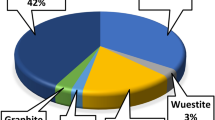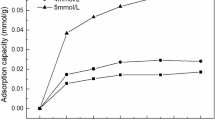Abstract
WHEN two ions capable of forming insoluble precipitates are brought together by diffusion through gels, sharp bands of precipitate are formed. This phenomenon was discovered by Liesegang1, who recognized its possible geological significance.
This is a preview of subscription content, access via your institution
Access options
Subscribe to this journal
Receive 51 print issues and online access
$199.00 per year
only $3.90 per issue
Buy this article
- Purchase on Springer Link
- Instant access to full article PDF
Prices may be subject to local taxes which are calculated during checkout
Similar content being viewed by others
References
Liesegang, R. E., Geologischen Diffusionen (von Theodor Steinkopf, Dresden and Leipzig, 1913).
Weiss, A., and Amstutz, G. C., Mineralium Deposita, 1, 60 (1966).
Trudinger, P. A., and Bubela, B., Mineralium Deposita, 2, 147 (1967).
Baars, J. K., thesis, Meinema, Delft (1930).
Temple, K. L., and Le Roux, N. W., Economic Geology, 59, 647 (1964).
Berner, R. A., Amer. J. Sci, 265, 773 (1967).
Author information
Authors and Affiliations
Rights and permissions
About this article
Cite this article
BUBELA, B., MCDONALD, J. Formation of Banded Sulphides: Metal Ion Separation and Precipitation by Inorganic and Microbial Sulphide Sources. Nature 221, 465–466 (1969). https://doi.org/10.1038/221465a0
Received:
Revised:
Issue Date:
DOI: https://doi.org/10.1038/221465a0
This article is cited by
-
Toward an integrated genetic model for vent-distal SEDEX deposits
Mineralium Deposita (2018)
-
Characterization of Fe-S minerals influenced by buried ancient woods in the intertidal zone, East China Sea
Science Bulletin (2009)
-
The Geology and Habitability of Terrestrial Planets: Fundamental Requirements for Life
Space Science Reviews (2007)
-
The origin of rhythmic sulphide bands from the Permian sandstones (Weissliegendes) in the footwall of the Fore-Sudetic “Kupferschiefer” (Poland)
Mineralium Deposita (1992)
-
Ore structures and genesis of the lead-zinc-deposit Tynagh, Ireland
Geologische Rundschau (1980)
Comments
By submitting a comment you agree to abide by our Terms and Community Guidelines. If you find something abusive or that does not comply with our terms or guidelines please flag it as inappropriate.



